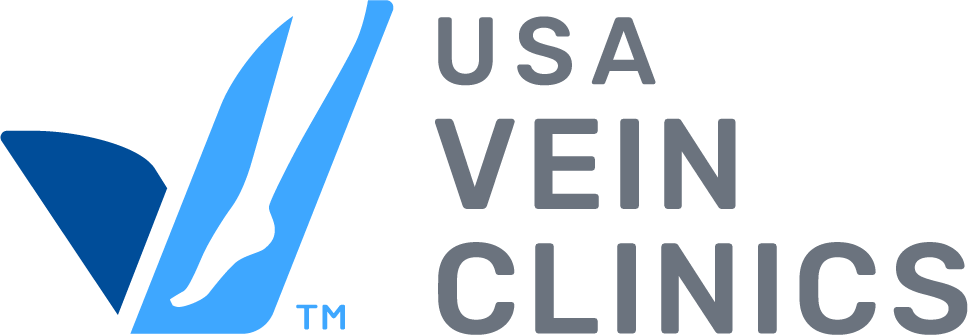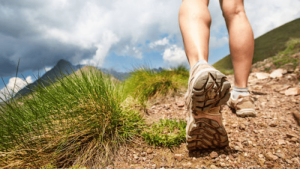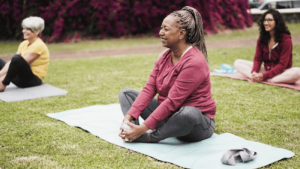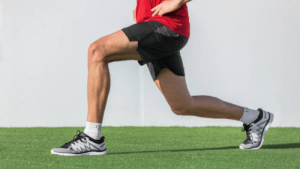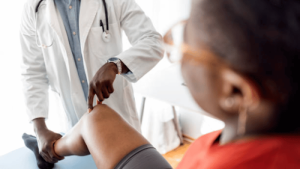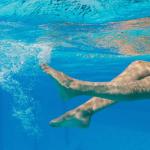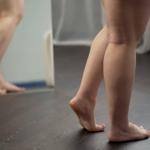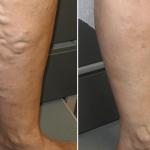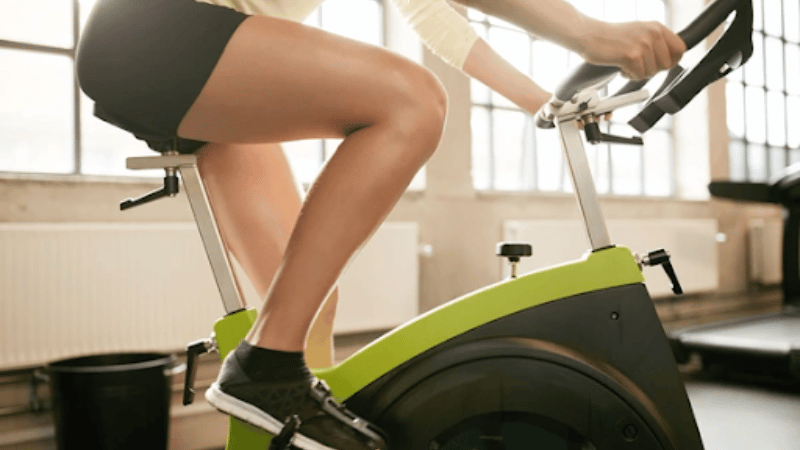
Varicose veins are enlarged veins that typically appear on the legs and feet, caused by weakened or damaged vein valves. Without treatment, they can worsen over time.
Can exercise help with varicose veins?
Exercise can help reduce varicose vein symptoms and prevent vein issues from recurring after varicose vein treatment. Regular physical activity is not only beneficial for managing symptoms but also plays a crucial role in maintaining long-term vein health. By promoting better circulation and strengthening the muscles that support your veins, exercise may even prevent future varicose veins from forming.
How Does Exercise Help with Varicose Veins?
Exercise won’t cure varicose veins. However, it can help relieve some discomfort if you have throbbing pain, calf cramps, swelling, and other symptoms caused by damaged veins. Staying active is also an excellent way to manage vein health until you get proper vein treatment.
Exercise helps varicose veins by:
- Improving circulation — blood flows more easily through the veins with exercise.
- Toning your muscles — stronger leg muscles support your veins by helping them pump blood back to the heart.
- Helping you maintain a healthy weight — being overweight increases your chances of having vein issues due to the added pressure that is put on your veins, particularly in the legs.
Your calf muscles play a crucial role in this process, acting as pumps that move blood from your feet and legs back to your heart. Regular exercise enhances this natural mechanism, improving overall circulation. It not only alleviates the discomfort but also reduces swelling, which can significantly improve both the look and feel of varicose veins.
One of the leading causes of varicose veins is prolonged periods of sitting or standing. Being inactive can cause blood to pool in the veins, putting more pressure on the vein walls and valves, which can contribute to the development of varicose veins. Exercise offsets this by consistently promoting blood flow, which helps prevent blood from pooling and reduces the risk of developing additional varicose veins.
While exercise won’t cure existing varicose veins, it is a proactive step to improve symptoms and minimize the risk of future vein issues, ensuring your legs look and feel healthier over time.
But what type of exercise is best for varicose veins?
10 Varicose Vein Exercises
If you have bulging veins and experience swelling and leg pain, you may worry that exercise will worsen your condition. However, incorporating exercise into your daily routine is essential for your vein health, cardiovascular health, and overall well-being.
Here are the best exercises that will work with your varicose veins, not against them, and help you keep your health on track.
Exercise #1: Walking
Walking is a low-impact workout that is great for people with varicose veins. The benefits of walking for varicose veins include:
- Improved blood glucose and blood pressure levels
- Enhanced blood circulation
- Strong bones
- Decreased pain from vein disease, arthritis, and fibromyalgia
By strengthening your calf muscles, you are aiding in circulation, which benefits those with varicose veins.
Try to walk for at least 30 minutes, five days a week. If you can speed up your walking pace, that is great too. Brisk walking raises your heart rate without being risky and helps burn more calories.
Walking Guide for Pre- & Post-Vein Treatment
Exercise #2: Biking or Elliptical
Hopping on a bike or an elliptical is another great option for varicose veins. These exercise machines are low-impact, like walking. They also help build your calf muscles and strengthen your heart.
Start slow if you’re new to biking or exercising on an elliptical. Begin with 10 to 15 minutes of exercise and work up to 30 minutes.
Exercise #3: Bicycle Legs
This exercise will be like riding a bicycle while lying on the floor.
- Lay down on your back on a mat or the floor, and raise your legs in the air, bending them at the knee to make a 90-degree angle
- Slowly kick your right leg out while keeping your left leg bent
- Return your right leg to the starting position and switch
- Keep this fluid motion going
If you’re feeling adventurous, you can incorporate your arms (and abdominals) to take this workout one step further. Simply crunch up and tap your right elbow to your bent left knee, then switch arms as you switch your legs. This will help improve circulation and strengthen your core, which can reduce the pressure on your veins and alleviate varicose vein symptoms.
Exercise #4: Kneeling Leg Lifts
This is another workout you can do at home to manage varicose vein symptoms and requires no equipment.
- Get down on all fours
- Lift one leg up and extend outward, making an ‘L’ shape
- Hold for a few seconds
- Lower and repeat
- Do 10 times on each leg, rest, and do another round
Exercise #5: Calf Raises
As mentioned above, building the strength of your calf muscles helps a great deal in improving your body’s blood circulation, and calf raises are a fabulous way to do that.
- Stand up straight, legs parallel
- Rise up onto your tiptoes
- Slowly lower back down
Do three sets of 10 or as many reps as you feel comfortable.
Exercise #6: Thigh Raises
This exercise can be done while watching TV or hanging around the house. The only equipment needed is a chair.
- Sit down in the chair
- Stand up
- Repeat 10-15 times, rest and do another round
Exercise #7: Side Leg Lifts
- Lay on your right side, legs stacked on top of each other
- Slowly lift your left leg up in the air, hold for a moment, and bring back down
- Do this several times, and then switch to the other side.
- Lay on your left side, and again, stack your legs
- Slowly lift your right leg, hold, and bring back down
This exercise works your legs and your obliques.
Exercise #8: Ankle Rolls
If most of your day is spent sitting down, don’t worry—you can still do some exercises that will help your circulation. Here’s a great one to do at your desk.
- Keep your heels on the ground but lift the rest of your feet
- Roll your feet clockwise for 15 seconds
- Roll your feet counterclockwise for 15 seconds
- Rest and do another round
Exercise #9: Rocking
This exercise is similar to the calf raises with one extra step, this workout will help improve your balance.
- Stand up straight with your heels together, toes pointed out
- Rise up on your tiptoes
- Slowly lower back down
- Rock back to your heels, toes off the ground
- Return to start, and repeat
Exercise #10: Toe Pull-Back
Sit in a chair to do this quick and easy exercise to keep that blood flowing smoothly through your legs.
- Keep the heel on the floor and pull your toes back towards your body
- Do this 15 times, rest, and do another round
Varicose Vein Exercise Considerations for Women
Women are more likely to get varicose veins than men—it’s estimated that 22 million women in the United States have varicose veins, compared to 11 million men.
Women experience a higher risk for osteoporosis and possible bone fractures, especially after menopause.¹ Because of this, some women may prefer to focus on low-impact exercises and flexibility to keep their veins healthy and maintain a healthy weight.
Yoga, in particular, offers substantial benefits for individuals with varicose veins. By building strength and flexibility, yoga can help alleviate the pain and swelling often associated with varicose veins. Additionally, practicing yoga can be advantageous for maintaining overall strength and flexibility as you age, offering both immediate relief and long-term benefits for vein health.
Some of the best low-impact exercises for varicose veins are:
- Swimming
- Yoga
- Tai chi
- Water aerobics
Incorporating these activities into your routine can promote healthy veins and improve your overall well-being.
Varicose Vein Exercise Considerations for Men
Men aren’t as likely to develop varicose veins, but it’s still a common condition, especially for men over 50. Men are more at risk for high blood pressure, a condition that can contribute to developing varicose veins, compared to women.²
Focusing on cardiovascular activities and weight training can help prevent weight gain, maintain healthy blood pressure, and strengthen leg muscles to better support the veins.
Here are some exercises ideal for men looking to protect their veins. These exercises can also be beneficial for anyone who can safely perform higher-impact activities:
- Tennis
- Pickleball
- Lunges
Exercises that Might Cause Stress to Your Veins
For people with varicose veins, it can be better to stay on the safe side and refrain from doing exercises that could stress the veins without talking to a doctor first.
Running
Running offers incredible cardiovascular benefits, such as blood pumping and promoting circulation, but it can be too high-intensity for people with moderate to severe varicose veins.
Running puts significant strain and pressure on your legs due to the impact on the treadmill or ground.
However, people with mild vein issues can opt for a slow jog on grass or another soft surface, which helps reduce the negative effects of high-impact running on a treadmill or concrete.
Weightlifting
Weightlifting strengthens muscles, bones, and joints while speeding up the metabolism, helping the body maintain a healthy weight.
However, lifting heavy weights can put additional stress on your body, including your veins, due to the increased pressure on your vascular system and the strain from holding your breath during heavy lifts.
Here are four things you should do if you lift weights and have varicose veins:
- Swap out the heavyweights for lighter ones
- Don’t forget to exhale as you lift
- Wear compression socks during and after lifting
- Consult with a personal trainer to learn how to lift with proper form
When to See a Vein Specialist for Varicose Veins
Varicose veins are a symptom of chronic venous insufficiency or vein disease. In its early stages, this condition causes leg swelling, spider veins, and bulging varicose veins. Advanced chronic venous insufficiency can lead to more serious symptoms, including throbbing pain and leg ulcers.
You should consult with a vein specialist if you notice any signs of chronic venous insufficiency, including varicose veins. This condition increases the risk of developing deep vein thrombosis (DVT) and can lead to increased vein damage if left untreated, impacting overall vascular health.
Consult with a Vein Specialist at USA Vein Clinics
Staying active is important for ensuring your veins are as healthy as possible, even if you already have varicose veins. You can use exercises that boost circulation and strengthen your muscles without harming your veins.
Our expert vein doctors can also help you get relief from varicose veins and painful symptoms. We offer advanced non-surgical vein treatments that target damaged veins, enabling patients to experience lasting improvements to their vein health.
Schedule a consultation at a vein clinic near you to get started.
Frequently Asked Questions About Exercise and Varicose Veins
Can Exercise Make Varicose Veins Disappear?
Exercise can alleviate some of the discomfort associated with varicose veins by improving blood flow. However, it won’t make varicose veins disappear. The only way to get rid of varicose veins is by treating the damaged veins.
Our vein clinics offer minimally invasive treatments for varicose veins and spider veins. You can schedule a consultation at a clinic near you today and learn more about our vein treatments and how they can help you.
Is Walking or Running Better for Varicose Veins?
Walking is a better exercise for varicose veins because it doesn’t involve repetitive foot-pounding on the pavement like running, reducing the risk of further stress on damaged veins. Walking helps improve blood circulation, reduces blood pressure, and burns calories, which can prevent weight gain and reduce pressure on leg veins.
How Can I Stop Varicose Veins From Getting Worse?
Understanding the risk factors that may have contributed to vein damage can prevent varicose veins from getting worse. A sedentary lifestyle, being overweight, and stress all impact vein health.
While being active can help manage varicose vein symptoms, seeing a vein specialist is important to find the right treatment for the underlying condition.
Sign Up For Our Newsletter To Stay on Top of Your Health
Sources
- Khaled A. Alswat, “Gender Disparities in Osteoporosis,” Journal of Clinical Medicine Research 9 no. 5 (2017): 382–387.
- Bethany Everett and Anna Zajacova, “Gender differences in hypertension and hypertension awareness among young adults,” Biodemography and Social Biology 61 no. 1 (2015): 1–17.
Medically Reviewed By:
Dr. Yan Katsnelson is a philanthropist, business owner, and highly skilled cardiac surgeon. He is the Founder and CEO of USA Vein Clinics, which is part of USA Clinics Group, the parent company of USA Fibroid Centers, USA Vascular Centers, and USA Oncology Centers, with more than 100 facilities nationwide. Dr. Yan has established himself as a strong advocate for accessibility and affordability of the most advanced medical care close to home. His mission is to create a positive experience for each patient with compassionate, personalized, and expert care.
